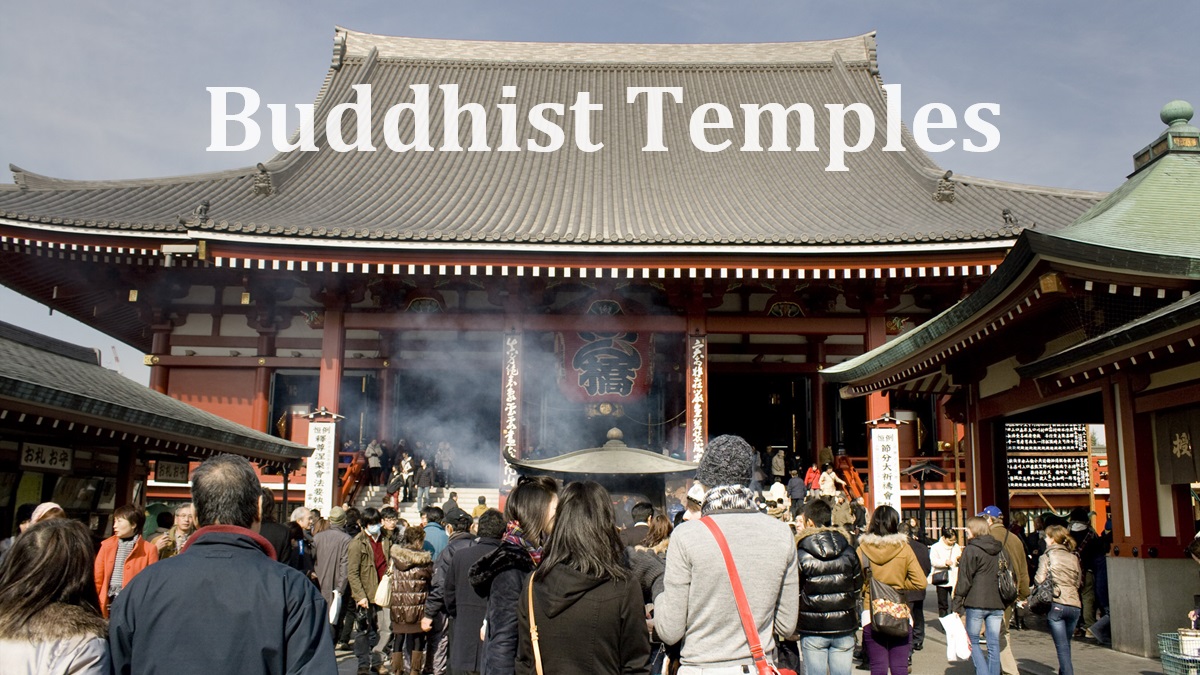Buddhist temple in Japan
Buddhist temple is the temple for Buddhism.
In Japanese, the end of temple name is "ji", "tera" or "dera".
Buddhism is a religion founded by the Indian Buddha in the 6th century BC.
It was introduced to Japan through China in the the 6th century AC, then it spread throughout the country.
There are about 75,000 Buddhist temples in Japan.
Buddhist temple enshrines the statues imitating the figure of Buddha and the priests read the sutras that Buddha preached the precepts.
According to interpretations of preaching, there are many sects in Japan.
"Zen" is also one of the sects.
The manner of worshipping is to hold the palms and fingers of both hands together and make a request to Buddha.
If a big incense burner is making smoke in front of worship hall, purify yourself by the smoke.
In Buddhism, it is said that the smoke of insence sends your wish to the heaven.
After worshipping, worshipper can buy the lucky charm and draw "Omikuji" (a fortune-telling slip).
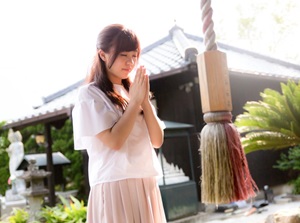
Worshipping in Buddhist temple
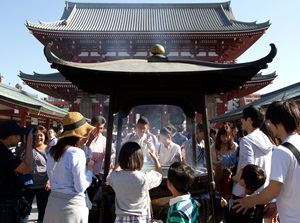
Incense burner in Sensoji in Tokyo
Of course, Buddhist temple is the place for worship.
But there are historic buildings, artistic Buddhist sculpture, Japanese paintings, Japanese gardens in many temples.
So, you can see many Japanese traditional arts in Buddhist temple.
By the way, you may find the mark "卍" on the facility in Buddhst temple.
It is a happy mark for Buddhism from ancient times, and it is also used as the map symbol for Buddhist temple in Japan.
It has nothing to do with Nazi.
About Buddhism and Shinto, see the following page.
Popular Buddhist temples in each region
Tohoku Kanto Koshin-etsu Hokuriku Tokai Kansai Chugoku Shikoku Kyushu
Popular Buddhist temples in Tohoku Region
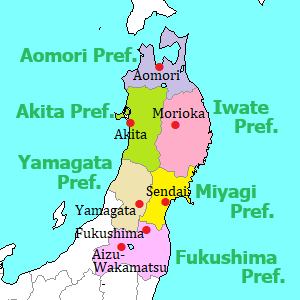
Osorezan (恐山, Aomori Pref.) is a mysterious holy place in a caldera volcano.
The temple was founded in 862, and the surrounding scenery looks like the world after death.
Chusonji (中尊寺, Iwate Pref.) was built in 1126.
The main temple "Konjikido" is covered with gold leaf and it is the first national treasure in Japan.
Yamadera (山寺, Yamagata Pref.) was founded in 860.
The main temple is on the top of a cliff and the visitors must climb the long approach to the temple.
Popular Buddhist temples in Kanto Region
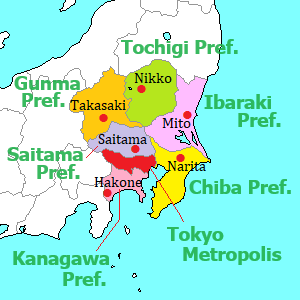
Sensoji (浅草寺, Tokyo) is one of famous sightseeing spots in Tokyo, and is in Asakusa.
It is said that a small temple was set up in 628.
The entrance gate is "Kaminarimon" and there is a popular approach "Nakamise" with many souvenir shops.
Gotokuji (豪徳寺, Tokyo) is an old Buddhist temple in the western part of central Tokyo.
It is said that this temple is the birth place of Maneki-neko (beckoning cat), so many Maneki-nekos are enshrined.
Kawasaki Daishi (川崎大師, Kanagawa Pref.) was founded in 1128, and it is in Kawasaki city.
The location is near Tokyo, so the number of visitors during the first three days of the New Year is one of the top of all temples and shrines in Japan.
Kamakura (鎌倉, Kanagawa Pref.) was the city where the first samurai government had been placed from 1192 to 1333.
Many Buddhist temples were built in the city.
Naritasan Shinshoji (成田山新勝寺, Chiba Pref.) was founded in the 10th century.
The precinct is relatively wide and there are some temples and a park.
This temple also has many visitors.
Ooyaji (大谷寺, Tochigi Pref.) is an old Buddhist temple in the suburbs of Utsunomiya city.
It was built in a cave at the foot of a rocky cliff. and the main Buddha images are carved on the cliffs.
Popular temples in Koshin-etsu Region
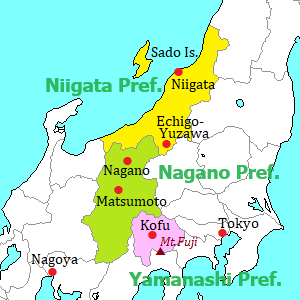
Zenkoji (善光寺, Nagano Pref.) is in Nagano city, and it was founded in 644.
A Buddhist statue from China in the 6th century is never unveiled.
The substitute statue made between the 11th and 13th century is unveiled every 7 years.
Kuonji (久遠寺, Yamanashi Pref.) was founded by high priest Nichiren in 1244.
The main precinct is on the side of Mt.Minobu, and there is also a temple on the top of the mountain.
Popular temples in Hokuriku Region
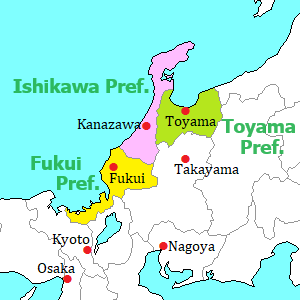
Eiheiji (永平寺, Fukui Pref.) was founded in 1244.
It is a large Zen temple, and many temples are connected by corridors on the slope.
We can see the working ascetic monks in the temple.
Ninja-dera (忍者寺, Ishikawa Pref.) is the temple at the edge of Kanazawa city and it was built in 1643.
The real name is "Myoryuji"(妙立寺).
It was built for city defense, so samirais stationed and the building had various tricks and traps like Ninja house.
Popular temples in Tokai Region
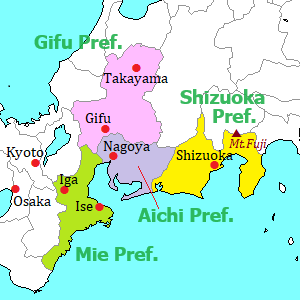
Shuzenji (修禅寺, Shizuoka Pref.) was founded by high priest Kuukai in 807, and it is in Izu city.
Kuukai found a hot spring here, so this area became a popular hot spring resort.
Toyokawa Inari (豊川稲荷, Aichi Pref.) is a Zen temple built in 1441 and it is in Toyokawa city.
"Inari" is a god of industry, so it is generally a Shinto shrine.
But this temple enshrines the Inari god.
So, there are "Torii" gates for Shinto along the approach, and the statues of fox as the symbol of Inari are seen.
Osu Kannon (大須観音, Aichi Pref.) is located in Osu district in the center of Nagoya city and it came to here in 1612 after the foundation in 1333.
Osu is a town of pop culture in Nagoya, and the temple is the symbol.
Nittaiji (日泰寺, Aichi Pref.) is a temple in Nagoya city, but it doesn't belong any religious sects of Buddhism.
The King of Thailand presented the ash of Buddha, the founder of Buddhism in the 5th century BC, to Japan in 1900, then it was enshrined in this temple.
Popular temples in Kansai Region
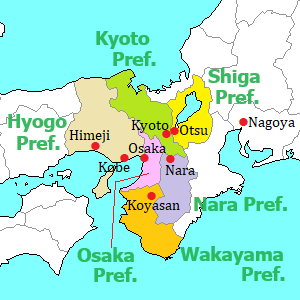
Temples in Nara
Nara is the first capital city in Japan from 710 to 794.
Buddhism was introduced from China in the middle of the 6th century, but it became the the basis of the government.
Some Buddhist temples were built in and around both cities at that time.
So, existing temples in Nara are almost the oldest in Japan.
Especially, the following are famous.
Todaiji (東大寺) was constructed from 743 to 752, and the famous Great Buddha was completed in 758.
Toshodaiji (唐招提寺) is a Buddhist temple in the suburbs of Nara city.
It was founded in 759 by a high priest invited from China.
Horyuji (法隆寺) is also a Buddhist temple in the suburbs of Nara city.
It was founded in the early 7th century, so the buildings are famous as the oldest wooden construction of all existing in the world.
Temples in Kyoto
Kyoto became the capital city from Nara in 794, and lasted until 1868 for over 1,000 years.
The court nobles built the Buddist temples as symbols of power, so there are many temples in Kyoto.
The following are popular in many temples in and around Kyoto.
Sanjusangen-do (三十三間堂) was built in 1266.
The temple name means "temple with 33 column spacings", and 1,000 statues in the temple are spectacular.
Kiyomizu-dera (清水寺) is on the slope of the mountainside and a broad terrace attached in front of the main part of the temple is very attractive.
And some approaches to the temple are popular.
Nanzenji (南禅寺) is a large temple built in the 1290s.
There are many buildings, and the Japanese gardens and scenery are beautiful.
Ginkakuji (銀閣寺) was originally the villa built by retired Shogun in 1483, and it was changed to Zen temple after his death.
Therefore, the villa and Japanese garden is main of the site.
Ruriko-in (瑠璃光院) was a villa built in the 19th century, and it became a Buddhist temple in 2005.
The Japanese garden is very attractive, so this temple became popular rapidly by social media.
Kinkakuji (金閣寺) was originally the gorgeous villa built by retired Shogun in 1397, and it was changed to Zen temple after his death.
The main temple covered with golden leaves is very famous.
Ryoanji (龍安寺) is a Zen Buddhist temple founded in 1450 and the rock garden is well-known.
With seeing the simple but meaningful garden, we can enjoy thinking something silently.
Toji (東寺) is the oldest temple in Kyoto, and it was built in 796 when Kyoto city was constructed as the capital.
Many buildings in the temple are designated as national treasures, and the Five-story pagoda is the highest in Japan.
Sanzen-in (三千院) is an old Buddhist temple in Ohara district in the northern part of Kyoto.
The Japanese gardens covered with moss are beautiful.
Byodo-in (平等院) is a Buddhist temple built in 1052 and is located in Uji city to the south of Kyoto.
The central hall Hoodo is designated as a national treasure.
Other Buddhist temples in Kansai Region
Koyasan (高野山, Wakayama Pref.) is a sacred town of Buddhism in the mountain.
In the 9th century, Kuukai who was one of the greatest Buddhist priests in Japan constructed the town to practice Buddhistic austerities in the mountain.
There are many temples and many priests still practice asceticism.
Shitennoji (四天王寺, Osaka city) is a wide Buddhist temple in the center of the city.
It was founded in 593, and it is one of the oldest temples in Japan.
Enryakuji (延暦寺, Shiga Pref.) was founded in 822,.
It is located near the top of Mt.Hiei rising between Otsu city and Kyoto city.
It is an important temple, and many priests are doing hard training in this temple.
Ishiyamadera (石山寺, Shiga Pref.) was founded in 747, and it is in Otsu city.
"Ishiyama" means "mountain of stone", so this temple is on the huge rock bed.
Murasaki-Shikibu, a woman novelist, wrote the Japan's first (or the world's first) full-length novel in this temple in 1004.
Popular temples in Chugoku Region
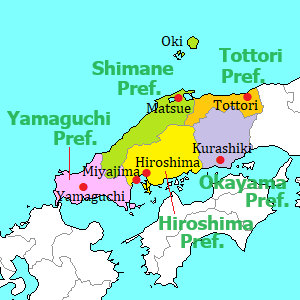
Sanbutsuji (三仏寺, Tottori Pref.) was founded in 706.
It is located in the mountain and a temple designated as a natioanl treasure is on the rocky cliff wall.
If the visitor want to go to the temple, you must climb the rock wall.
Kosanji (耕三寺, Hiroshima Pref.) is a Buddhist temple founded by the priest changed from successful businessman in 1936, and is in Ikuchi Island.
All buildings in the temple are modeled after the famous historic structures in Japan.
Rurikoji (瑠璃光寺, Yamaguchi Pref.) was founded in the end of the 14th century and it is in Yamaguchi city.
The five-story pagoda built in 1442 is designated as a national treasure.
Shikoku 88 temples pilgrimage

Kuukai who constructed Koyasan was born in Shikoku island.
He practiced asceticism in many temples in Shikoku, and the 88 temples are associated with Kuukai.
The pilgrimage to the temples had done by the training priest since around the 14th century.
It is said that the common people began to make a pilgrimage in the late 19th century.
Many pilgrims from all over the country visit Shikoku throughout the year.
The length of the pilgrimage route is about 1,400 km.
If you walk on all route, it takes 5 to 8 weeks.
Popular temples in Kyushu Region
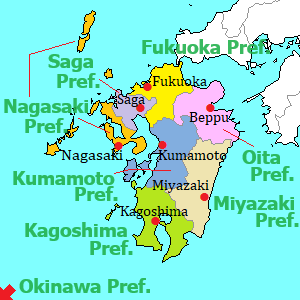
Kanzeonji (観世音寺, Fukuoka Pref.) is near Dazaifu-tenmangu shrine in Dazaifu city.
It was built in 746, and there is the temple bell designated as a national treasure.
Rakanji (羅漢寺, Oita Pref.) was founded by Indian priest in 645 and is located by the steep cliff in Yabakei gorge in Nakatsu city.
A lot of stone statues of Buddha in the cave are attractive.
Usuki Stone Buddhas (臼杵石仏, Oita Pref.) are in Usuki city.
They are the Japan's greatest Stone Buddhas created from the 10th to the 14th centuries and are designated as national treasures.
It is a sacred place and Buddhist ceremonies are held several times a year.

